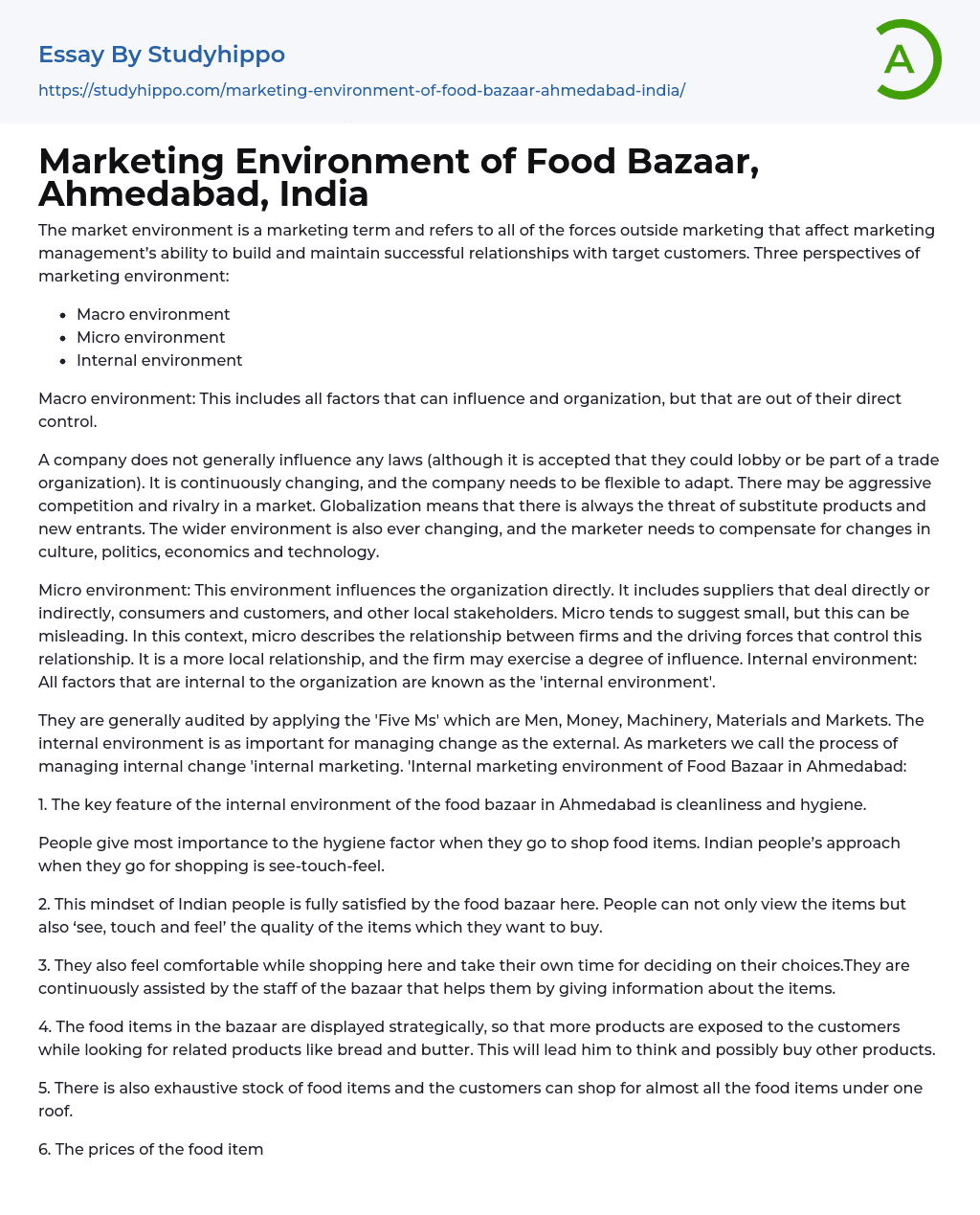

Marketing Environment of Food Bazaar, Ahmedabad, India Essay Example
The term "market environment" in marketing refers to all external forces that impact a marketing management's capacity to establish and sustain successful connections with target customers.
Three perspectives of the marketing environment:
- Macro environment:
This category encompasses all factors that have the potential to affect an organization but are beyond its direct control. While a company cannot typically influence laws, it may engage in lobbying or become part of a trade organization. The macro environment is dynamic and requires adaptability from the company. Market competition can be intense. - Micro environment:
This designation covers factors that directly impact a company's ability to serve customers and are in close proximity to the organization. It includes suppliers, customers, competitors, and other stakeholders. The micro environment can be influenced by strategic decisions made by the company. - Internal environment:
This pertains to factors within the organization itself, su
...ch as employees, culture, resources, and capabilities. The internal environment plays a critical role in shaping both the company's marketing strategy and overall success.
Globalization brings about frequent chances for substitute products and potential new rivals. Moreover, the overall environment is always changing, necessitating marketers to adjust to cultural, political, economic, and technological alterations. The micro environment has a direct impact on the organization and includes suppliers, consumers, customers, and other local stakeholders. Despite its name suggesting something small-scale, the term "micro" can be deceptive.
The term "micro" in this context pertains to the connection between firms and controlling forces, with a focus on localized influence. The internal environment encompasses all factors within the organization and is evaluated through a Five Ms audit: Men, Money, Machinery, Materials, and Markets.
The internal environment is crucial for effectively managing change, both internally and
View entire sampleJoin StudyHippo to see entire essay
externally. Within the marketing field, this process is referred to as 'internal marketing.' Food Bazaar in Ahmedabad has a specific internal marketing environment characterized by a primary focus on cleanliness and hygiene. When customers visit the store to purchase food items, the hygiene factor holds utmost significance for them.
The Indian approach to shopping is characterized by the process of see-touch-feel. This mentality is completely fulfilled by the food bazaar, where people not only have the opportunity to see products but also have the chance to physically interact with them and assess their quality. Additionally, individuals feel at ease while shopping here and have ample time to make decisions on their purchases. The bazaar's staff is always available to assist customers by providing information about the items.
4. The food items in the bazaar are strategically showcased to maximize customer exposure to a range of products as they look for essentials like bread and butter, enticing them to explore and possibly buy additional items.
Customers can find a wide range of food options at the bazaar, fulfilling almost all their food needs in one convenient location. Furthermore, the prices for these items are economical and comparable to those outside the bazaar. Moreover, various seasonal discounts and enticing offers are introduced to attract customers.
The micro environment of the food bazaar in Ahmedabad comprises consumers, stakeholders, and suppliers. The consumers are primarily middle to high-class individuals who have a substantial monthly income and are willing to pay a premium for superior quality food products. The stakeholders include the owners, partners, and affiliated companies of the food bazaar.
Big Bazaar and Himalaya are the owners of the food bazaar in Ahmedabad. They
make decisions regarding various operational activities, such as cash outflow for advertising and promotions. Perishable food items are supplied by local vendors, while non-perishable items are supplied by companies through time-based agreements. The macro environment of the food bazaar in Ahmedabad is politically favorable, with the government offering incentives for further expansion of retail outlets in the city.
Economic: The retail market can effectively target the "upper middle class" strata of society due to the high per capita income.
Socio-cultural: The choice of goods in Gujarat is based on social factors. Since the majority of people in Gujarat are vegetarian, non-vegetarian items are virtually absent.
The effective use of a Management Information System is crucial for keeping track of position inventory and orders in the field of technology.
- Food Safety essays
- Food Security essays
- Beverages essays
- Cuisines essays
- Dairy essays
- Desserts essays
- Fast Food essays
- Bread essays
- Meal essays
- Meat essays
- Organic Food essays
- Rice essays
- Sugar essays
- Taste essays
- Beef essays
- Coconut essays
- Crowd essays
- Dinner essays
- Juice essays
- Sainsbury essays
- Cooking essays
- Ginger essays
- Oreo essays
- Drink essays
- Beer essays
- Wine essays
- Coffee essays
- Tea essays
- Cake essays
- Hamburger essays
- Ice Cream essays
- Burger essays
- Pizza essays
- Fruit essays
- Lemon essays
- Food Waste essays
- Favorite Food essays
- Alcoholic essays
- Soft Drinks essays
- Cookie essays
- Starch essays
- Yeast essays
- Cola essays
- Pizza Hut essays
- snack foods essays
- chips essays
- Biscuit essays
- Brewing essays
- Brewery essays
- Advertising essays



